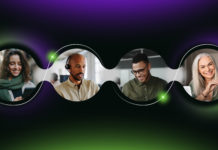An Excerpt from Digital Customer Service: Transforming Customer Experience for an On-Screen World, available now
One of the biggest misconceptions around customer service today is the difference between “phone” and “voice.” In a Digital-First world, they are not synonyms—at all! In fact, the difference between the two is fundamental to Digital Customer Service (DCS) and enabling a seamless digital customer experience.
In our book Digital Customer Service: Transforming Customer Experience For An On-Screen World, Glia CEO Dan Michaeli recounts a “light bulb” moment he had during the early launch phase of the Digital Customer Service platform:
It’s the same thing. But it’s completely different.
Imagine two conversations between the same two people—in this case, a customer and an Agent. In both conversations they are working together to get something done or solve some problem.
It’s the same two people discussing the same exact issue. But customers were describing these two kinds of conversations as totally different experiences.
This is the thought that clicked in my head as I started listening to feedback from customers of the earliest companies to transform their Service operations to DCS. These were the people who were among the first to experience OnScreen Enhancements seamlessly woven into their digital journeys.
I was thinking about all the data I’ve seen in the trade press over the past decade about “the increase in customer resistance to using the phone.” The assumption has always been that as customers become more digitally self-sufficient they don’t want to have to talk to anyone any more.
For example, it’s become conventional wisdom that “Millennials don’t talk on the phone–to ANYONE!” So it makes sense that customer research shows increasing preference for texting over talking.
But here were these customers who were having their first-ever interactions with agents in DCS (through OnScreen Voice) and they were scoring 90% on CSAT, 15-20 points higher on NPS (and lower for customer effort) across the board. Older people AND younger people.
So, if people don’t like talking to a Customer Service agent, how could THAT be?
What we’re learning is: Customers don’t, in fact, hate talking. What they hate is feeling forced to have to dial a phone number that is disconnected from their digital experience. Many will do almost anything to avoid having to.
But that can lead to other problems. What about situations that require additional diagnosis, or where a person isn’t confident they know what they need or want? Those are handled much more effectively with a live interaction. Or what about situations in which an interaction with an agent could lead to greater long-term revenue for the company?
As we learn more about the psychology of customers who engage in DCS interactions, we’re seeing that if a person is already in the midst of trying to do something on a website or app, if they THEN need some help but have a verbal conversation with an agent through their own screen—their reaction is almost 180-degrees different than if they had to give up and dial a phone number to reach Service.
The reason: In DCS, if you want to talk, there’s no need to start all over. Whether it’s an OnScreen Voice conversation or video chat, and especially if there’s an opportunity for the customer and agent to be working on the same screen through CoBrowsing—it’s still the same two people, taking care of the same issue, but it feels like a completely different experience.
People may not dislike “talking to another human being” as much as we’ve all been led to believe.
What they really dislike is having to stop what they were doing online, then finding a phone number, calling that number, going through a slew of IVR options (hoping they’ve picked the right selection), waiting on hold for who-knows-how-long, listening to the same looping soundtrack of elevator music (hoping they won’t get disconnected) until an agent finally picks up … and THEN makes them start the process all over again.
Maybe that’s the part they hate.
We hope you found this book excerpt beneficial and now see the difference between “Phone” and “Voice.” The book goes into more detail on how to allow customers to talk with a human without breaking the digital connection to make an old-timey phone call. For more book excerpts, check out our previous blogs:
Learn more about the book Digital Customer Service: Transforming Customer Experience for an On-Screen World and order your copy today!





